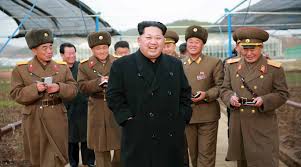North Korea Missile Launches, Nuclear Detonations: Timeline

published Apr 15th 2017, 7:26 pm, by Sam Kim
(Bloomberg) —
The North Korean weapons program now testing U.S. President Donald Trump stretches back decades, when the regime began reverse-engineering Scud missiles acquired from Egypt. International efforts to curb North Korea’s nuclear threat were dealt a setback in 2006 with the country’s first successful bomb test, and former leader Kim Jong Il abandoned talks a few years later. His son and successor, Kim Jong Un, has only accelerated the program, testing more sophisticated technology in defiance of international sanctions.
Here’s a detailed history of North Korea’s weapons programs:
1976-81: North Korea begins missile development using Scud-B from the Soviet Union and launchpad from Egypt
1984: First Scud-B missile test firing
1988: Operational deployment of Scud-B and Scud-C missiles
1990: First Rodong missile test firing
July 1994: North Korea’s founding leader Kim Il Sung dies, allowing son and heir Kim Jong Il to assume full leadership
1998: Operational deployment of Rodong missiles, which have a range of 1,300 kilometers (800 miles). Firing of Taepodong-1 missile, which North Korea says was satellite launch
January 2002: U.S. President George W. Bush cites weapons programs in placing North Korea alongside Iran and Iraq in an “ axis of evil”
2003: North Korea withdraws from the Non-Proliferation Treaty, begins acquiring weapons-grade plutonium from spent fuel rods. First so-called six-party talks held to resolve concerns over the country’s activities, including China, Japan, Russia, South Korea and the U.S.
2005: North Korea announces possession of nuclear weapons and its withdrawal from six-party talks aimed at ending its atomic program
July 2006: Test firings of Taepodong-2, Rodong and Scud missiles. The Taepodong-2 is a long-range missile that capable of traveling 15,000 kilometers and striking U.S. targets. Even so, analysts say it’s mostly used to launch satellites and would be difficult to convert into a rocket that can deliver weapons
October 2006: The official Korean Central News Agency announces a “successful nuclear test”
2007: Operational deployment of Rodong missiles
April 2009: Firing of Taepodong-2 missile, which North Korea says was satellite launch. United Nations strengthens sanctions and North Korea withdraws from six-party talks
May 2009: North Korea carries out second nuclear test
July 2009: Test-firing of Scud and Rodong missiles
December 2011: North Korean leader Kim Jong Il dies, clearing way for Kim Jong Un to take power
April 2012: North Korea reports failed Unha-3 rocket launch
December 2012: North Korea launches Unha-3 rocket that puts its first satellite into space
February 2013: North Korea conducts third underground nuclear test
August 2013: North Korea reported to have restarted nuclear reactor to produce plutonium
May 2015: North Korea claims to have tested a submarine-launched missile; says it developed technology to mount nuclear warhead on a missile
July 2014: North Korea conducts series of missile tests ahead of Chinese President Xi Jinping’s visit to Seoul
September 2015: North Korea threatens nuclear attack against U.S. and reaffirms its main reactor is operational. South Korean President Park Geun-hye says North will “ pay a price” for fourth test
December 2015: Kim Jong Un says North Korea is “ready to detonate” a hydrogen bomb
Jan. 6, 2016: North Korea says it successfully tests hydrogen bomb
Feb. 7, 2016: North Korea launches a long-range rocket that it says successfully put a satellite into orbit
Aug. 24, 2016: North Korea successfully launches a ballistic missile from a submarine
Sept. 5, 2016: North Korea fires three ballistic missiles about 1,000 kilometers, at least one of which entered Japan’s air defense zone
Sept. 9, 2016: North Korea conducts fifth nuclear test
Oct. 16, 2016: North Korea fires a ballistic missile that immediately explodes after launch
Feb. 12, 2017: North Korea fires an intermediate-range Pukguksong-2 ballistic missile into nearby seas, drawing a joint rebuke from Trump and Japanese Prime Minister Shinzo Abe, who were meeting in Florida
March 6, 2017: North Korea fires four ballistic missiles, with three falling into Japan’s exclusive economic zone
April 16, 2017: North Korea fired an unidentified ballistic missile that exploded almost immediately after launch, defying warnings from the Trump administration to avoid any further provocations
To contact the reporter on this story: Sam Kim in Seoul at skim609@bloomberg.net To contact the editors responsible for this story: Daniel Ten Kate at dtenkate@bloomberg.net Brendan Scott
COPYRIGHT
© 2017 Bloomberg L.P
NICODES



No Comment